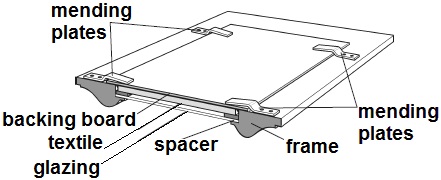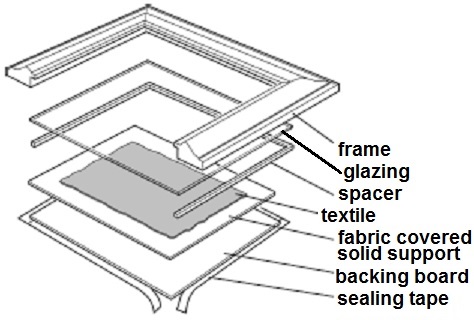Conservation Framing of Embroideries and Other Flat Textiles – Canadian Conservation Institute (CCI) Notes 13/17
CCI Note 13/17 is part of CCI Notes Series 13 (Textiles and Fibres)
Introduction
This Note provides instruction for framing flat textiles that have been mounted onto a solid support. It builds upon the information provided in CCI Notes 13/6 Mounting Small, Light, Flat Textiles. The materials and methods described herein are applicable to flat textiles in museum collections as well as to contemporary needlecraft intended for home display. N.B. The issues involved in dealing with mounted textiles that have already been framed are beyond the scope of this Note, and are not dealt with here. These textiles should be referred to a professional textile conservator.
Why Frame?
Framing provides textiles with physical protection from dust, pollutants, accidental soiling, and direct handling. It can also enhance their appearance. Indeed, textile samplers were traditionally framed so that they could be proudly displayed.
When to Consult a Professional Textile Conservator
Most embroideries, pieces of lace, and even small quilts can be safely framed. However, problems can occur with textiles glued to acidic cards and boards, as well as those that exhibit any of the following conditions:
- fugitive dyes
- mould
- insect attack
- powdering threads
- stains
- adhesive residues
- splits
- tears
- losses
These textiles should be referred to a professional textile conservator prior to framing, as inappropriate attempts to deal with the problems could lead to further damage.
Framing: Past and Present
Some traditional mounting and framing techniques and materials are no longer recommended because they do not fulfill conservation requirements. For example, textile samplers were often attached to a wood board or stretcher with metal tacks spaced at intervals. However, this method created holes and uneven tension in the textile, and often caused staining as the metal tacks corroded. In addition, a sampler attached to wood was exposed to acidity and resins, and one mounted on stretchers would act as an air filter and trap airborne dirt and pollutants.
Contemporary framers use many materials and techniques, all of which are acceptable for mounting and framing textiles when long-term preservation is not a primary concern. However, only some of them are appropriate for museum textiles or family heirlooms that one is trying to preserve for future generations (i.e. of archival quality). It is important to have a clear understanding of the difference and know what to ask for.
Materials
Materials used to mount and frame textiles should be acid-free, chemically stable, and waterfast (i.e. contain no colorants that run in water). Examples of acceptable materials include:
- acid-free matboard (buffered or unbuffered), made from either 100% rag or highly purified wood pulp, referred to as alpha cellulose
- corrugated (or fluted) plastic board (e.g. Cor-X, Coroplast, Poly-Flute), made from poly acid-free foam boards (e.g. Fome-Cor, Artcore), which are sandwiches of foam, usually extruded polystyrene foam, set within paper or plastic sheets
- wood or wood products (but only if they are sealed with an aluminum barrier foil such as Marvelseal)
- needlefelted polyester felt or batting
- prewashed fabric
The following materials are unacceptable and should never be placed in direct contact with textile artifacts:
- acidic papers, cards, and matboards
- unsealed wood and wood products such as Masonite
- coloured materials that are not waterfast
- glues, adhesive tapes, adhesivecoated boards
- sprays of any kind (e.g. “relaxant” sprays, “protective” sprays, insecticides)
- staples, tacks, nails
Cleaning
Textiles should be cleaned before they are mounted and framed. For most textiles, this entails mechanical surface cleaning as described in CCI Notes 13/16 Mechanical Surface Cleaning of Textiles. Non-coloured textiles (e.g. whitework embroidery and lace) that are in good condition except for soiling or discoloration can also be gently washed following the procedures described in CCI Notes 13/7 Washing Non-coloured Textiles.
Mounting
Textiles should be mounted onto a fabric-covered solid support before they are framed. For textiles in poor condition, consult a qualified textile conservator for advice on mounting. For textiles in sound condition, follow the procedure outlined in CCI Notes 13/6 Mounting Small, Light, Flat Textiles. This method provides overall support and is easily reversed without damaging the textile. In all cases, it is useful to discuss dimensions with the framer before the mounting is done.
Spacers
Spacers elevate the glazing slightly above the textile. This prevents the three-dimensional quality of elements such as embroidery from becoming crushed. It also reduces the risk of moisture condensing on the glazing if the framed textile is advertently exposed to a cold, damp environment (moisture could cause tidelines or mould growth, which could ubsequently stain and weaken the textile). One common spacer is acid-free matboard. This can be cut into a window mat slightly larger than the textile (Figure 1). If the window mat must cover part of the textile, elevate it with one or more narrower mats to prevent the edge of the window from pressing into the textile (Figure 2). Alternatively, if a window mat is not desirable for aesthetic reasons or space limitations, acid-free matboard can be cut into strips narrower than the frame's rabbet and attached to the glazing with 3M #415 double-sided tape. Plastic spacer strips such as Framespace and Inner Space (available at framing shops) can also be used. These products can be cut to any length, and attached to the glazing either mechanically or with 3M #415 double-sided tape (Figure 3).

Frame, window mat, glazing, textile, fabric covered solid support, backing board, and sealing tape.

Frame, window mat, spacer mats, glazing, textile, fabric covered solid support, backing board, and sealing tape.

Frame, spacer - strip of acid-free card or plastic, glazing, textile, fabric covered solid support, backing board, and sealing tape.
Glazing
Glazing reduces damage from airborne dust and pollutants (e.g. cigarette smoke), as well as from accidental soiling. Glazing that filters out ultraviolet (UV) radiation also provides some protection against light damage — although protection is not complete so ambient light levels must still be controlled. Glazing can be either glass or plastic. Both materials are available with UV-absorbing filters and both have certain drawbacks: glass is heavier than plastic and breaks more easily; plastic scratches more easily than glass and can generate sufficient static charge to attract loose threads or fibres when it is wiped. For more information regarding the suitability of various glazing materials, see CCI Notes 11/3 Glazing Materials for Framing Works on Paper.
Backing Boards
Backing boards provide additional protection from dust and accidental blows. Although they are separate from the mounted textile (i.e. there is no direct contact), they should still be made of stable materials such as the matboard and plastic boards listed previously in “Materials”. Backing boards should be inserted directly in the frame. To secure the board, insert finishing nails with a brad pusher or tack hammer, taking care not to split the moulding. If the rabbet is not deep enough to insert a backing board, attach the board to the back of the frame with brass mending plates (Figure 4).

Mending plates, backing board, textile, glazing, spacer, and frame.
Sealing the Frame
Sealing the frame prevents the intrusion of dust and airborne pollutants. The most common way to seal a frame is to apply adhesive tape across the point where the backing board meets the frame. Brown kraft tape is typically used, but gummed linen tape (which is more stable) is a better choice. If the backing board is corrugated plastic, pressure-sensitive cloth tapes such as Filmoplast SH Tape and University Products Sealing Tape should be used to ensure proper adhesion. Sealing can also be accomplished by taping a piece of sturdy archival paper to the frame around all four sides. The layered structure of a typical framed textile is illustrated in Figure 5.

Frame, glazing, spacer, textile, fabric covered solid support, backing board, and sealing tape.
Display of Framed Textiles
Even properly framed textiles can be damaged by inappropriate temperature and light conditions, which cause colours to fade and fibres to weaken. Therefore, when choosing a location to display framed textiles:
- observe where the sun shines at different times of the day and avoid those locations in the room
- avoid areas above or next to fireplaces, radiators, or heating vents (sources of heat or hot air currents)
- avoid exterior walls of unheated buildings (sources of cold damp)
It is also important to avoid attaching light fixtures to frames, as these produce excessive light levels in localized spots.
Suppliers
Note: The following information is provided only to assist the reader. Inclusion of a company in this list does not in any way imply endorsement by the Canadian Conservation Institute.
Acid-free matboard (neutral or pH buffered):
art and drafting supply stores, framing shops, suppliers of conservation materialsEndnote 1
Acid-free (neutral pH) gummed linen tape:
suppliers of conservation materialsEndnote 1
Cor-X, Coroplast, Polyflute:
plastics suppliers, framing shops, some art and drafting supply stores
Double-sided tape (3M #415):
suppliers of conservation materialsEndnote 1
Framespace, inner space:
framing shops
Marvelseal:
suppliers of conservation materialsEndnote 1
Sealing tapes:
suppliers of conservation materialsEndnote 1
Bibliography
Mailand, H.F., and D.S. Alig. Preserving Textiles: A Guide for the Nonspecialist. Indianapolis: Museum of Art, .
By the staff of the CCI Textile Lab
Également publié en français.
Also available in French.
©Minister of Public Works and Government
Services Canada,
Cat. Nº NM-95-57/13-17-2010E
ISSN 0714-6221